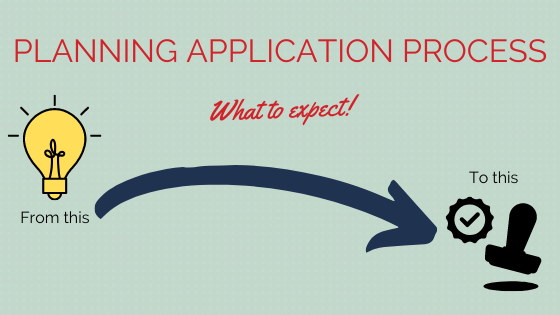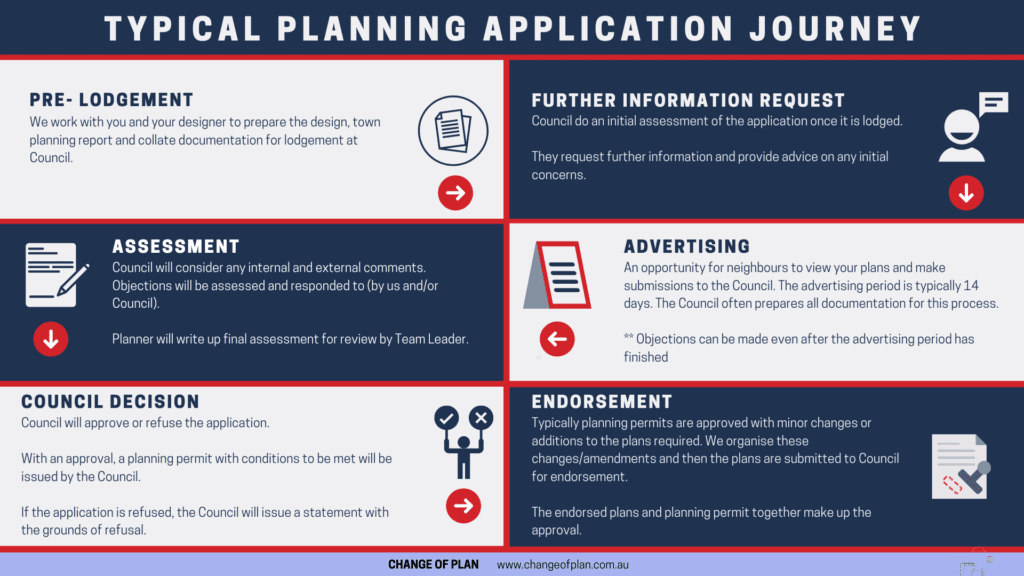15 May Journey of a Typical Planning Application

We have previously talked about the typical timeframes for getting planning approval, but I thought it would also help people to know a little of what to expect with a planning application. So here goes!
Pre-Lodgement
The journey begins (for us) at pre-lodgement. This is the stage when the concept is worked through. The details of the proposed use or development are discussed and finalised. During this stage the necessary plans are drawn up and we prepare the planning report to accompany the application. Once the details are finalised we lodge the completed application in to the Council.
Initial Assessment
Now the planning application starts its journey with the Council. Following lodgement the application is allocated to a town planner. They will then do an initial assessment of the project and request any additional information that they require. At this stage they will often tell us if there are any initial concerns or issues with the proposal. Giving us an opportunity to discuss further with them and amend the plans prior to advertising if necessary.

Advertising
After the information is submitted back in to Council and they are satisfied the application will then be advertised. While not all planning applications will be required to be advertised, the majority will as the Council take a cautious approach in making sure the neighbours are advised of proposals near them. Advertising will typically be carried out for 14 days. Many of the Council’s use a contractor for the advertising notices and so there is little to do (other than pay the advertising fee). While objections are usually received during this 14 day period, objections are still valid after that date and can be received up until the Council make a decision on the application.
Final Assessment
Once advertising is complete we await the final assessment of the application by the Council planner. During this stage any objections will be discussed and if necessary a consultation meeting may be organised by the Council. Also, any referral comments received after the initial assessment will be discussed if necessary. Generally though, not much happens to the outside observer at this time, as we wait for the planner to write their report and have it reviewed by their team leader.
Council Decision
Once the report and decision has been signed off by the team leader a copy of the formal decision will be sent to us. The possible decisions will be:
Approval – A Planning Permit will be issued with conditions
Refusal – A Notice of Refusal will be issued with grounds (reasons) of refusal
Notice of Decision – This is a temporary state used when the Council approves the application but there are objectors. It provides a copy of all future planning permit conditions and gives the objectors an opportunity to appeal the decision at VCAT. After 28 days the appeal window is closed for objectors and the Council will then issue the final Planning Permit.
Endorsement
Lastly, if a Planning Permit has been issued it often contains changes to the plans that Council want. If so, the plans need to be modified in accordance with the Planning Permit and then submitted back in to Council for endorsement. Once the plans are endorsed the approval is complete and town planning is finished.
Appeals
While appealing a decision at Victorian Civil and Administrative Tribunal (VCAT) is not part of the typical planning application journey, I thought it would be useful to mention here. You can read more about VCAT here.
There are three reasons/types of main planning appeals:
Objector Appeals
This is following the issue of a Notice of Decision, where an objector then decides to lodge an appeal of Council’s decision at VCAT. Technically this appeal is between the objector and Council, however as VCAT will reconsider the application and make a decision on whether to approve it or not we strongly recommend that you actively participate in this appeal.
Conditions Appeal
This is when Council have issued a Planning Permit (or a Notice of Decision) and you want to appeal against one or more conditions on the appeal. For this type of appeal VCAT is only considering the conditions in question and deciding whether to allow them, delete them or change them. The decision to approve the planning application itself is “safe” as that is not part of the appeal.
Appeal Against a Refusal
This type of appeal is when the Council refuses a planning application and the applicant wishes to appeal that decision at VCAT.

